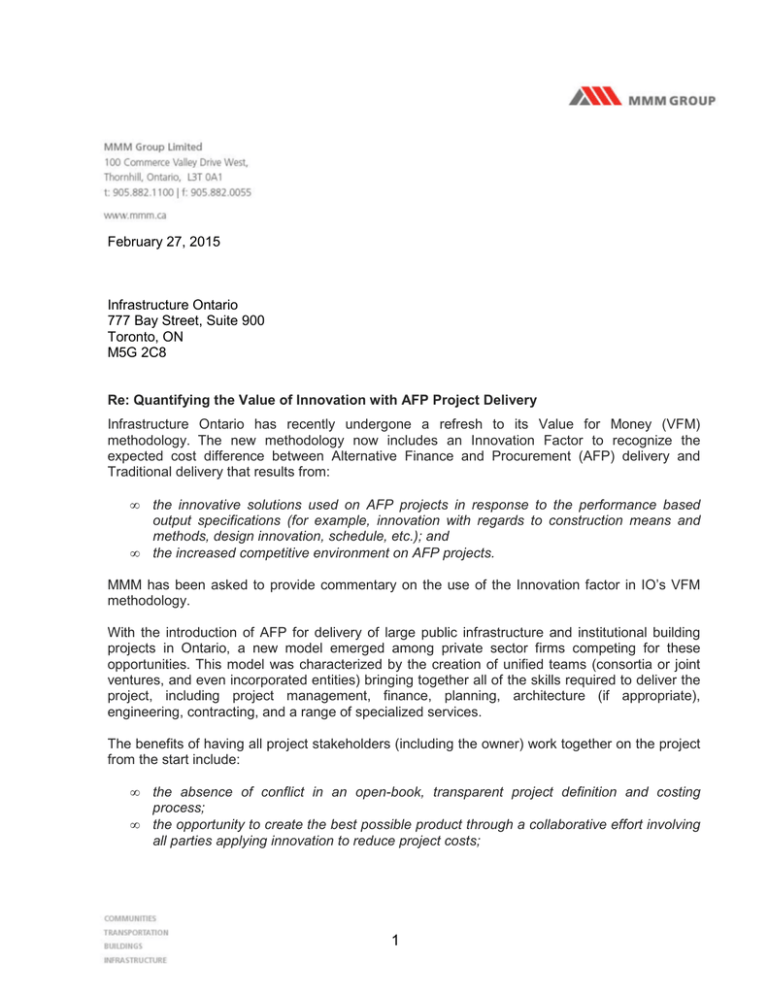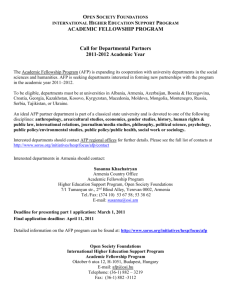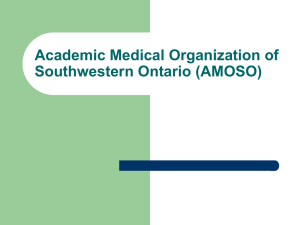Quantifying the Value of Innovation with AFP Project Delivery
advertisement

February 27, 2015 Infrastructure Ontario 777 Bay Street, Suite 900 Toronto, ON M5G 2C8 Re: Quantifying the Value of Innovation with AFP Project Delivery Infrastructure Ontario has recently undergone a refresh to its Value for Money (VFM) methodology. The new methodology now includes an Innovation Factor to recognize the expected cost difference between Alternative Finance and Procurement (AFP) delivery and Traditional delivery that results from: • • the innovative solutions used on AFP projects in response to the performance based output specifications (for example, innovation with regards to construction means and methods, design innovation, schedule, etc.); and the increased competitive environment on AFP projects. MMM has been asked to provide commentary on the use of the Innovation factor in IO’s VFM methodology. With the introduction of AFP for delivery of large public infrastructure and institutional building projects in Ontario, a new model emerged among private sector firms competing for these opportunities. This model was characterized by the creation of unified teams (consortia or joint ventures, and even incorporated entities) bringing together all of the skills required to deliver the project, including project management, finance, planning, architecture (if appropriate), engineering, contracting, and a range of specialized services. The benefits of having all project stakeholders (including the owner) work together on the project from the start include: • • the absence of conflict in an open-book, transparent project definition and costing process; the opportunity to create the best possible product through a collaborative effort involving all parties applying innovation to reduce project costs; 1 • • • • • • the addition of constructability to the process of design and development; the ability to achieve a high level of cost certainty early in the project development process; the provision of a high level of date certainty by shortening time frames from what would be the case in conventional design/bid/build delivery; the allocation of project risks to the party best suited to manage them; the application of life cycle costing and the avoidance of “low bid”, low quality solutions; and the maintenance of a competitive, transparent bidding process. Two studies were undertaken by MMM Group Limited for Infrastructure Ontario concerning budgeting capital costs in the highway and transit sectors. The studies reviewed project data and obtained professional advice regarding the difference in capital costs for major components of civil works (both highways and transit) and transit vehicle acquisition that could be expected under different methods of procurement. A key part of the studies involved interviews conducted with leading Canadian and international construction and concession companies in the AFP/PPP sector. Companies such as PCL, SNC Lavalin, Dragados, ACS, Ellis Don, AECON and Hochtief were interviewed. The study findings confirm that projects delivered by AFP (DBFM and DBFOM) produce significant savings in both hard and soft costs through: • • • synergies and avoidance of duplication; the application of value engineering and innovation; and the avoidance of ‘scope creep’. The main advantages of AFP projects identified in the survey of major contractors and developers are: • • • • • enhanced project innovation; better life cycle costing; condensed schedules; the transfer of specific risks to the party best able to manage them; and the opportunity to select the best team to develop and deliver the project. In order to gather additional data in support of the assumptions and findings of this report, a questionnaire was developed for the purpose of interviewing leaders in the AFP/PPP industry. The contractors/developers all agreed that civil works provide the greatest opportunity for innovation and cost savings with the margin of savings of 10% to 15%, and in some cases as high as 20% to 30%. 2 The contractors and developers also confirmed that contractors continually look for opportunities to add value and reduce the costs of their bid. By undertaking Value Engineering (VE) investigations and considering innovative and alternative ways to deliver a project where savings can be realized, they are able to reduce the ‘hard’ costs of a project. Major contractors are more familiar with new and different civil construction methods than most owners are and they are more willing to assume risk to achieve savings in both cost and schedule. Under traditional delivery (TD) delivery, owners tend to do the opposite - they rely on reliable past means and methods, avoid risk to the extent possible and continue to rely on past experiences. One of the specific questions in the interview was: What are the potential margins for Savings (%) due to the opportunity for innovation by the contractor on major transportation projects? All responses indicated that innovation in AFP (DBFM and DBFOM projects) would account for savings in the range of at least 10% to 15%. Two responses indicated that innovation could deliver savings as high as 20% and 30% respectively. Based on MMM's experience, we would expect that the utilization of the AFP model in the delivery of major transportation projects would result in overall savings related to innovation in the order of 10 - 15 %. IO’s inclusion of an innovation factor in the VfM analysis recognizes these anticipated savings and is an appropriate adjustment to the methodology. To estimate these savings, IO has calculated the innovation factor by comparing the winning bid to the average of the bids received at the RFP stage of a project (across its portfolio of projects that have reached substantial completion). This method of calculation captures the innovation that the winning bidder has used to ensure it has a competitive, cost effective solution relative to the other bids and acts as a reasonable proxy for the difference in pricing one might expect when comparing a traditional and AFP delivery model. Yours truly, MMM GROUP LIMITED Rob Wanless, P. Eng. Vice President, Transportation Planning Partner 3


